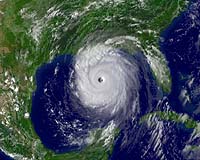 |
Pasadena CA (JPL) Aug 27, 2010 A relatively new type of El Nino, which has its warmest waters in the central-equatorial Pacific Ocean, rather than in the eastern-equatorial Pacific, is becoming more common and progressively stronger, according to a new study by NASA and NOAA. The research may improve our understanding of the relationship between El Ninos and climate change, and has potentially significant implications for long-term weather forecasting. Lead author Tong Lee of NASA's Jet Propulsion Laboratory, Pasadena, Calif., and Michael McPhaden of NOAA's Pacific Marine Environmental Laboratory, Seattle, measured changes in El Nino intensity since 1982. They analyzed NOAA satellite observations of sea surface temperature, checked against and blended with directly-measured ocean temperature data. The strength of each El Nino was gauged by how much its sea surface temperatures deviated from the average. They found the intensity of El Ninos in the central Pacific has nearly doubled, with the most intense event occurring in 2009-10. The scientists say the stronger El Ninos help explain a steady rise in central Pacific sea surface temperatures observed over the past few decades in previous studies--a trend attributed by some to the effects of global warming. While Lee and McPhaden observed a rise in sea surface temperatures during El Nino years, no significant temperature increases were seen in years when ocean conditions were neutral, or when El Nino's cool water counterpart, La Nina, was present. "Our study concludes the long-term warming trend seen in the central Pacific is primarily due to more intense El Ninos, rather than a general rise of background temperatures," said Lee. "These results suggest climate change may already be affecting El Nino by shifting the center of action from the eastern to the central Pacific," said McPhaden. "El Nino's impact on global weather patterns is different if ocean warming occurs primarily in the central Pacific, instead of the eastern Pacific. "If the trend we observe continues," McPhaden added, "it could throw a monkey wrench into long-range weather forecasting, which is largely based on our understanding of El Ninos from the latter half of the 20th century." El Nino, Spanish for "the little boy," is the oceanic component of a climate pattern called the El Nino-Southern Oscillation, which appears in the tropical Pacific Ocean on average every three to five years. The most dominant year-to-year fluctuating pattern in Earth's climate system, El Ninos have a powerful impact on the ocean and atmosphere, as well as important socioeconomic consequences. They can influence global weather patterns and the occurrence and frequency of hurricanes, droughts and floods; and can even raise or lower global temperatures by as much as 0.2 degrees Celsius (0.4 degrees Fahrenheit). During a "classic" El Nino episode, the normally strong easterly trade winds in the tropical eastern Pacific weaken. That weakening suppresses the normal upward movement of cold subsurface waters and allows warm surface water from the central Pacific to shift toward the Americas. In these situations, unusually warm surface water occupies much of the tropical Pacific, with the maximum ocean warming remaining in the eastern-equatorial Pacific. Since the early 1990s, however, scientists have noted a new type of El Nino that has been occurring with greater frequency. Known variously as "central-Pacific El Nino," "warm-pool El Nino," "dateline El Nino" or "El Nino Modoki" (Japanese for "similar but different"), the maximum ocean warming from such El Ninos is found in the central-equatorial, rather than eastern, Pacific. Such central Pacific El Nino events were observed in 1991-92, 1994-95, 2002-03, 2004-05 and 2009-10. A recent study found many climate models predict such events will become much more frequent under projected global warming scenarios. Lee said further research is needed to evaluate the impacts of these increasingly intense El Ninos and determine why these changes are occurring. "It is important to know if the increasing intensity and frequency of these central Pacific El Ninos are due to natural variations in climate or to climate change caused by human-produced greenhouse gas emissions," he said.
Share This Article With Planet Earth
Related Links More information on El Nino Earth Observation News - Suppiliers, Technology and Application
 Katrina Retrospective: 5 Years After The Storm
Katrina Retrospective: 5 Years After The StormGreenbelt MD (SPX) Aug 26, 2010 In early August 2005, Katrina was just a name. By September, it had become synonymous with the costliest and one of the deadliest tropical cyclones in U.S. history. Five years later, NASA is revisiting Hurricane Katrina with a short video that shows the storm as captured by NASA satellites. NASA provides space-based satellite observations, field research missions, and computer climate mode ... read more |
|
| The content herein, unless otherwise known to be public domain, are Copyright 1995-2010 - SpaceDaily. AFP and UPI Wire Stories are copyright Agence France-Presse and United Press International. ESA Portal Reports are copyright European Space Agency. All NASA sourced material is public domain. Additional copyrights may apply in whole or part to other bona fide parties. Advertising does not imply endorsement,agreement or approval of any opinions, statements or information provided by SpaceDaily on any Web page published or hosted by SpaceDaily. Privacy Statement |